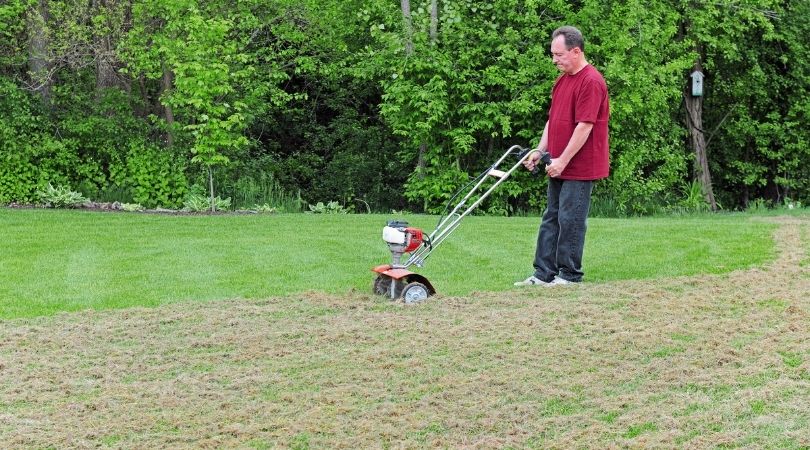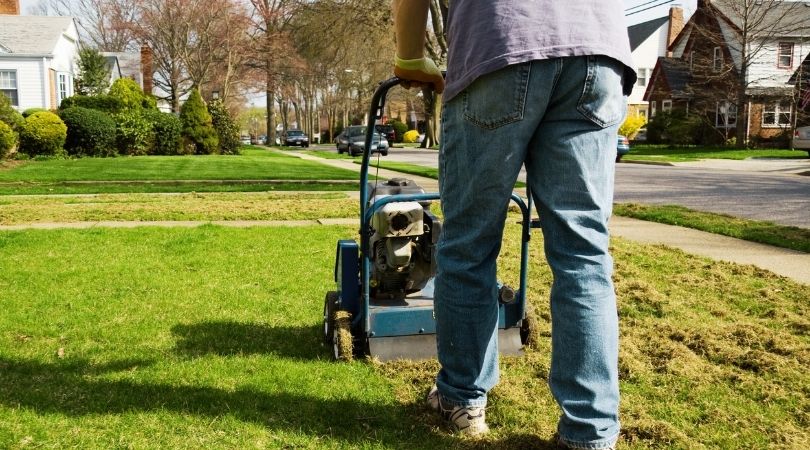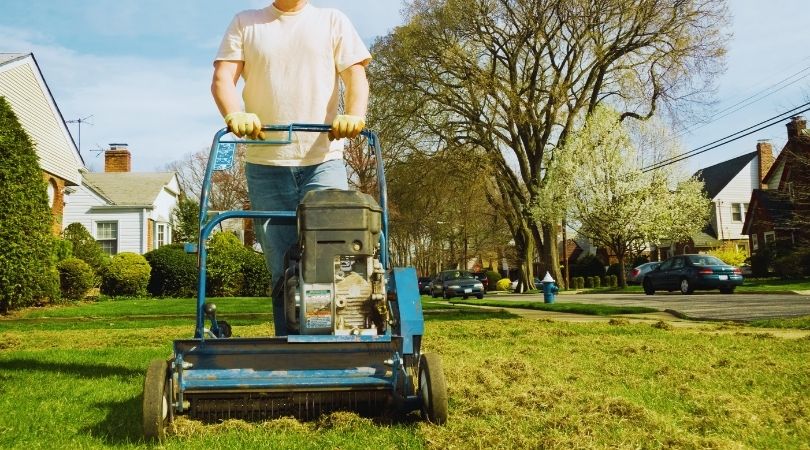Spring is in the air! That means time to start doing your lawn planning for the season ahead. If you’ve seen lawns that have benefited from it, but wondered what power raking is in lawn care, here are a few snippets of information to set you on your way.
Table of Contents
Why power rake?
At the end of a season, as the grass dies off, dead grass accumulates deep in your lawn. If this layer of dead grass isn’t removed, it builds up season after season until it forms a thick layer of thatch that smothers fresh growth.
It causes roots to thicken and yellow over time, they won’t reach as deep into the nutritious soil as they should, and as a result, your lawn will dry out. Perhaps not all at once, but it will struggle to get all the water and nutrients it needs for virile growth.
A thick layer of the previous seasons’ dead foliage in your lawn also provides a snug home for a variety of insects. And it promotes lawn diseases.
In the end, all of this will show.
A decent power rake is an answer.

How do I power rake my lawn?
You pretty much have two choices here:
You can do it yourself
This one is obvious. You can put in the elbow grease and get to work. But there are steps to take before you do this. More about that in a moment.
It can be expensive to rent a machine, and remember, it still requires effort. And if you don’t know what you’re doing, the attachments for the mower can easily rip out the healthy grass while you’re trying to get rid of the dead stuff.
If you are adamant to do it yourself, there are three basic methods:
- Manually – for a good ‘l manual rake, all you need is a strong back and a dethatching rake. If you have a small lawn and a thin layer of dead grass, this is more than ample.
- Use a power rake – a power rake looks like a mower, but it digs into the soil to pull out the dead layer. If your dead thatch isn’t too thick, thus will work really well. But be careful – it can be destructive if your grass isn’t settled and strong.
- Use a vertical mower – a vertical mower is much like a power rake, and they’re great if you have a thick layer of dead growth hiding under the surface.
Just remember, the whole process is invasive, so proper aftercare will be necessary for the lawn to heal properly. When you're done, rake up the excess debris, fertilize, and water properly.
Or you can hire a professional
This is the easy way. Especially if you haven’t done this before. Bear in mind that a thick amount of thatch build-up deep inside your lawn may need more than one power rake, so factor that into the costs if you decide to get someone to do the job for you.
Because it’s a great idea to aerate the lawn at the same time you power rake, a professional will be able to give you the best advice on the why, the when, and the how.

What are the benefits of a good power rake?
The benefits are numerous, but they all come down to one thing: lush, green growth for the whole season. A good power rake will:
- Promote the lush, healthy growth of grass
- Make the surface of your lawn super-smooth
- Make it easier for the fertilizers and nutrients to make their way deep into the soil
- Ensure your lawn’s root system gets adequate water and sunlight
Just a quick point on all of this – a good power rake is important BEFORE you aerate. With all the dead debris out of the grass and root system, the aeration process will help the fertilizer and the seeds to settle at optimum depths.
When should I power rake my lawn?
The best times (for most lawns) would be late winter or early spring. Keep an eye on your lawn. If you know it well, you’ll instinctively know when it is about to start greening. That’s your cue.
Also, grasses specifically adapted for cooler climes should be power rakes at the beginning or during the early part of fall.
Remember, power raking at the wrong time can cause serious damage. You don’t want to rip out living root systems and turf.
How do I know if my lawn even needs a power rake?
Never just assume your lawn needs to be power raked. If you take a spade or garden trowel and dig up a small wedge of your lawn grass (with the soil attached), you’ll be able to see and measure the layer of dead growth. If it’s between one and two inches, or even more, it will cause trouble.
In this case, you would probably already have noticed weak and thin growth and/or a bland lawn color. If that is the case, it’s time to power rake.
Cool, so what do I do after I power rake?
Once you’ve power raked and aerated, overseed properly. This will get your grass back in the healthy zone in no time flat. Make sure to use premium seed. No cost-cutting here. By overseeding with a good quality grass seed, you will start to overcome the need to power rake as the seasons pass.
There are plenty of good quality growth boosters on the market too. After a power rake, it’s also a good time to add one of those. If nothing else, they’re a GREAT fix for thin, anemic grass.
Also, make sure you check your lawn soil around every three years. Pay attention to things like pH levels. All of these work in concert to prevent thatch build-up and the consequent need for a power rake.

Just before you go …
If you keep an eye on the things we mentioned in this article, you’ll end up preventing the thatch build-up in your lawn. This, in turn, will limit the need for a power rake. You’ll keep your lawn green, and lush, and thick – something you’ll be proud of!
So, what is power raking in lawn care? It’s a maintenance process that, if done right and at the right time, will rejuvenate your lawn and lower the amount of seasonal care it needs in the years to come.

